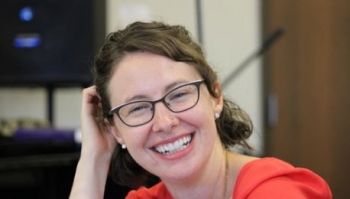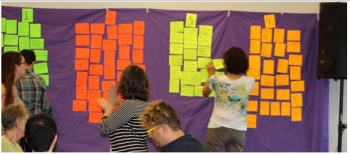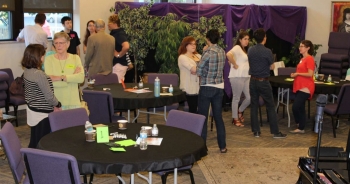When Minneapolitans hear the term “North Loop,” they know it has something to do with downtown, but aren’t necessarily sure where it is. And yet, the North Loop is gaining a unique identity. For those that don’t know, think Warehouse District.
More than 30,000 people now live in Downtown Minneapolis. And city plans assume that number will double in the next two decades. Old warehouse buildings are being converted into apartments and condominiums for people who work downtown and want an easy commute … and for people who simply like the energy that comes with living in the core part of the urban center.
The Minneapolis Area Synod’s Mission Table has long wondered about the viability of establishing a congregation in the midst of this growth and change. And Central Lutheran Church, the well-established Gothic Cathedral located on the other end of the downtown was considering the same thing. “Bishop Ann [Svennungsen] may have brought it up early in the [call] process for Peter Nycklemoe,” said Jim Hart, a member of Central’s council and recent call committee. She told the call committee that this opportunity is “something to consider in the call … [the congregation] may want to consider a pastor interested in such a new start.”
up early in the [call] process for Peter Nycklemoe,” said Jim Hart, a member of Central’s council and recent call committee. She told the call committee that this opportunity is “something to consider in the call … [the congregation] may want to consider a pastor interested in such a new start.”
About nine months ago, with Rev. Nycklemoe in place, recent seminary graduates Emmy Kegler and Marissa Sotos – on Central’s staff – were given the task of exploring this neighborhood and researching the viability of a new start congregation. From February to June, this duo hung out in “neighborhood-y” places to observe the realities of the North Loop.
After five months of research, the pair concluded that this increasingly residential neighborhood had people but little community infrastructure. After pouring over demographics and spending a preponderance of time in coffee shops, they realized that “no one is from here [the North Loop].” The neighborhood is made up primarily of single people in one-bedroom apartments; the people tend to be affluent but isolated.
While there are gyms, yoga studios, and boutiques, there really aren’t many public spaces for people to connect, listen, and talk, according to Marissa. The residents hunger for community, even if that’s not how they articulate it, she adds.
Although recently some suburban, evangelical congregations have set up second sites in the North Loop, there isn’t much of an established church present. And a need to meet these needs is palpable.
That’s what Marissa and Emmy reported to the Central Lutheran Church Council and to the synod’s Mission Table. A life-affirming and accessible place for gospel and rootedness would be a great contribution to this developing Minneapolis neighborhood.

WHEN PASTOR MARISSA SOTOS thinks of mission developers, she envisions rostered leaders “with big, extroverted personalities.” She adds, “And I’m not that.” So, the thought of being a mission developer was not on the horizon as Marissa attended the Lutheran School of Theology at Chicago.
But Marissa (ordained following the research stage) is a pastor who cares about context. Many people living in the North Loop, she explains, have had a bad experience with the church or have the conception that the church doesn’t want to connect with them because of their beliefs about science or other faiths.
“I think it is helpful to have a young, gay woman engaging their questions,” Marissa says. “I break down some of their fears [of the church’s assumptions].” She believes that people see more space for different sorts of individuals, and “that means this group could potentially include me.”
“Church experts say that the old attractive model isn’t working now with younger folks,” Jim Hart explains. “So, to think we would get very many people living in the North Loop or the warehouse district would find their way over to Central is wishful thinking. We think [Tree of Life] will be more complimentary to what Central is doing.” (Tree of Life is the working name of the synodically-authorized worshipping community because it draws on aesthetics of wholeness, health, abundance, and transformation.)
The folks who would be attracted to Tree of Life “would find it scary to walk into Central.” Church culture can really freak out people who aren’t used to it, she emphasizes.
Marissa knows the feeling. She didn’t grow up Protestant. When she started worshipping at Central, she found the experience somewhat “overwhelming.” So, she wants to find ways to make  worship accessible without losing its depth.
worship accessible without losing its depth.
She imagines that Tree of Life, which will worship at a rental space at the 514 Studios, will be a basic Vespers service, which is a little shorter and stripped of some of the pretense. There would be silence and singing, scriptures and candles, as well as a teaching (conversation) time. All of this allows for more significant participation from attendees.
Marissa is looking to her network of relationships (including synod congregations) for help with connections with people living in the North Loop. Although the ELCA, the Minneapolis Area Synod, and Central Lutheran are all providing resources, Tree of Life is not yet fully funded. In order to start worship services, it will be looking for additional support.
###
For more information about Tree of Life, visit treeoflifempls.org. Pastor Marissa can be reached at pastormarissa@treeoflifempls.org. Tree of Life will begin conversation groups this fall and worship next spring.
To support the Minneapolis Area Synod’s new start congregations, including Tree of Life, please send financial contributions to:
Minneapolis Area Synod
ATTN: Lynda Nordholm
122 West Franklin Avenue, Suite 600
Minneapolis, MN 55404
This article is second in a series on new start congregations in the Minneapolis Area Synod.

